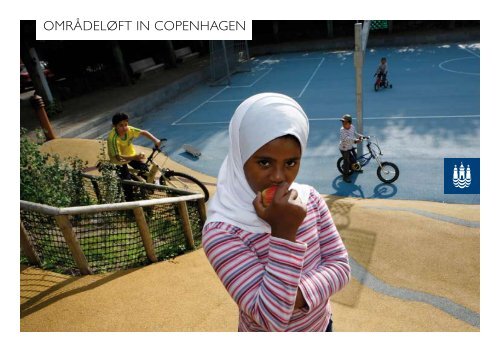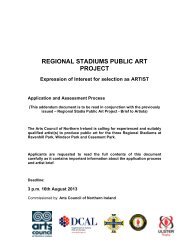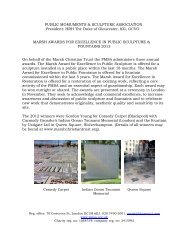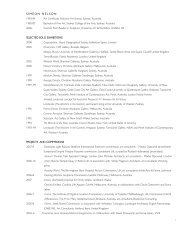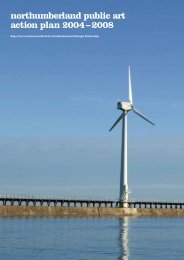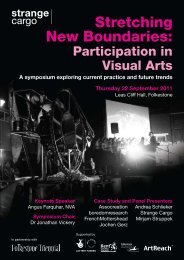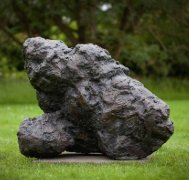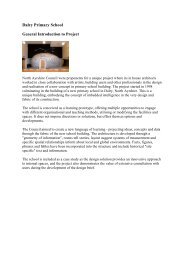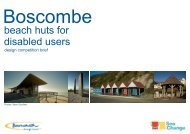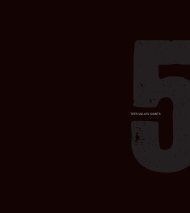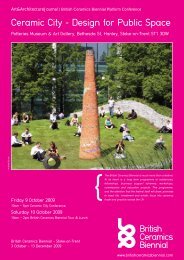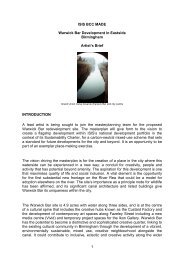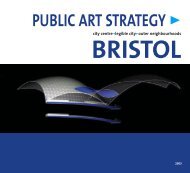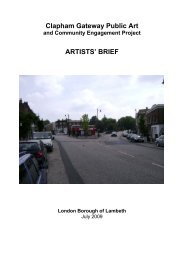Download the urban regeration plan - Public Art Online
Download the urban regeration plan - Public Art Online
Download the urban regeration plan - Public Art Online
You also want an ePaper? Increase the reach of your titles
YUMPU automatically turns print PDFs into web optimized ePapers that Google loves.
OmRåDEløFt In cOpEnhagEn<br />
FORSIDE
cOlOphOn cOntEnt<br />
Kvarterløft in Copenhagen<br />
Published<br />
October 2007<br />
Publisher<br />
City of Copenhagen<br />
The Technical and Environmental<br />
Administration<br />
Contact<br />
Urban Design Department<br />
Njalsgade 13, 2. floor<br />
Postbox 447<br />
1505 København V<br />
Tlf. 33 66 68 96<br />
E-mail bydesign@tmf.kk.dk<br />
Design<br />
Jakob Helmer<br />
The Technical and Environmental<br />
Admistration<br />
Communications Secretariat<br />
Print<br />
Jønsson & NKN<br />
Paper<br />
Printed on Galerie <strong>Art</strong> Silk<br />
ISO 14001, ISO 9002, EMAS<br />
Front page photo<br />
Gitte Lotinga<br />
OmRåDEløFt 2007 4<br />
SElEctIOn OF nEw OmRåDEløFt pROjEctS 11<br />
nøRREbRO paRk 12<br />
nORth-wESt 16<br />
mImERSgaDE 20<br />
øRESunDSvEj 24<br />
haRalDSgaDE 28
OmRåDEløFt 2007<br />
It is <strong>the</strong> residents of an <strong>urban</strong> district who decide<br />
which problems and solutions are to be focussed on<br />
Urban renewal<br />
The blue lights in <strong>the</strong> pavement in Holmbladsgade,<br />
renovation of Nørrebro Park<br />
and <strong>the</strong> nature playground in Urban<strong>plan</strong>en<br />
are all measures that have been carried out<br />
as a part of The Municipality of Copenhagen’s<br />
totality orientated <strong>urban</strong> renewal and<br />
“Områdeløft” (Integrated Urban Regeneration,<br />
also known as Kvarterløft). The<br />
renewal of a city is by no means just <strong>the</strong><br />
refurbishment of <strong>the</strong> physical infrastructure.<br />
“Områdeløft” is an initiative which<br />
focuses on specifically selected and clearly<br />
limited quarters which have a wide range<br />
of problems and shortfalls. The purpose of<br />
<strong>the</strong> initiative is to initiate new and positive<br />
physical, social, cultural and environmental<br />
development in <strong>the</strong> area.<br />
Resident decisions<br />
One of <strong>the</strong> most unique aspects of <strong>the</strong><br />
“Områdeløft” projects is that resident<br />
requests and reservations play a major role<br />
in determining project implementation.<br />
Local stakeholders are actively involved in<br />
all project development phases, to streng<strong>the</strong>ning<br />
resident and user involvement and<br />
ownership in <strong>the</strong> quarter. Streng<strong>the</strong>ned<br />
ownership helps ensure that project initiatives<br />
continue beyond project completion.<br />
Neighborhood regeneration, area<br />
renewal or partnership project?<br />
The Integrated Urban Regeneration initiative<br />
in Copenhagen had, up to 2007, several<br />
different names. These were Kvarterløft,<br />
area renewal and partnership projects<br />
and <strong>the</strong>y all had approximately <strong>the</strong> same<br />
goals. Kvarterløft was <strong>the</strong> name of <strong>the</strong> first<br />
attempt at integrated <strong>urban</strong> regeneration,<br />
which started in 1996. This name was<br />
changed, as requested by <strong>the</strong> government,<br />
in 2004 to area renewal (områdefornyelse).<br />
However, in 2007 <strong>the</strong> municipality decided<br />
to incorporate all <strong>the</strong>se initiatives under<br />
one new name, ‘Områdeløft’. The intention<br />
is that <strong>the</strong> new name should signal a continuation<br />
of <strong>the</strong> close relationship with <strong>the</strong><br />
now well-tested and successful Kvarterløft<br />
concept, whilst promoting an association<br />
with <strong>the</strong> formal name area renewal.<br />
The initiative today consists of two<br />
neigborhood regeneration projects which<br />
end at <strong>the</strong> end of 2007. In addition <strong>the</strong><br />
application for a new “Områdeløft” project<br />
in 2008 is in progress.<br />
The projects<br />
“Områdeløft” projects should promote<br />
positive development. The selected project<br />
area districts are <strong>the</strong>refore to have high<br />
levels of potential and qualities prior to<br />
development. The areas are fur<strong>the</strong>rmore<br />
typically characterised by having a high<br />
proportion of small, obsolete housing units,<br />
a relatively poor or run down infrastruc-<br />
1. North-West<br />
2. Nørrebro Park<br />
3. Mimersgade<br />
4. Haraldsgade<br />
5. Øresundsvej<br />
1.<br />
2.<br />
3.<br />
4.<br />
5.
6 OmRåDEløFt 2007<br />
7<br />
ture (recreational areas, institutions etc.),<br />
integration problems and a high proportion<br />
of inhabitants outside <strong>the</strong> labour market.<br />
Physical and social <strong>plan</strong>ning are <strong>the</strong>refore<br />
both an important part of <strong>the</strong> “Områdeløft”<br />
process. The physical development<br />
of <strong>the</strong> area is to a great extent <strong>the</strong> most<br />
visible aspect of “Områdeløft” to residents<br />
and <strong>the</strong> public at large. The physical<br />
projects are also capable of attracting high<br />
levels of interest from residents when<br />
forming working groups and at resident<br />
meetings. Social initiatives have focussed<br />
on network building measures to get <strong>the</strong><br />
district to function better socially. Almost<br />
all activities have as one of <strong>the</strong>ir goals <strong>the</strong><br />
streng<strong>the</strong>ning of <strong>the</strong> district’s social network.<br />
Activities which are aimed at social<br />
problems are carried out in close co-operation<br />
with The Municipality of Copenha-<br />
gen’s o<strong>the</strong>r social and housing projects.<br />
Financing<br />
“Områdeløft” is characterized by an<br />
unconventional financing model in which<br />
<strong>the</strong> state, <strong>the</strong> municipality, private funds,<br />
private landowners, companies and associations<br />
all contribute. Even though “Områdeløft”<br />
is funded at <strong>the</strong> initial stage by public<br />
funds, many projects are co-financed. Co-financing<br />
is contributed by funds such as The<br />
Danish Foundation for Culture and Sports<br />
Facilities, by residents and businesses.<br />
The Områdeløft process - general<br />
outline<br />
“Områdeløft” projects pass through three<br />
different phases. The first phase is <strong>the</strong> area<br />
<strong>plan</strong> phase. At this stage <strong>the</strong> first resident<br />
meetings are held, working groups are<br />
formed and an area <strong>plan</strong> is developed in<br />
co-operation with <strong>the</strong> municipal administration.<br />
The area <strong>plan</strong> is prepared and is<br />
<strong>the</strong>n approved by <strong>the</strong> political system. The<br />
implementation phase <strong>the</strong>n begins. At this<br />
stage, project ideas are developed, <strong>plan</strong>ned<br />
in detail and implemented to <strong>the</strong> greatest<br />
extent possible. The process ends with<br />
<strong>the</strong> anchoring phase in which <strong>the</strong> future of<br />
<strong>the</strong> many activities and physical projects<br />
implemented are clarified.<br />
It is important to be aware that anchoring<br />
is carried out to ensure that implemented<br />
projects are maintained and that<br />
<strong>the</strong> implemented activities and initiatives<br />
continue to progress. The anchoring phase<br />
is also used to accumulate experience and<br />
to incorporate <strong>the</strong> methods developed in<br />
“Områdeløft”.
FactS<br />
Områdeløft<br />
• Wishes to promote<br />
positive development<br />
• Is focussed on specific areas and has<br />
clear geographical delimitations<br />
• Is integrated<br />
• Builds on resident involvement<br />
and local commitment<br />
• Is limited in time to a period of 5 years<br />
• Is initially publically financed,<br />
but is co-financed by funds,<br />
residents and businesses.<br />
• Passes through three phases -<br />
district <strong>plan</strong> phase, implementation<br />
phase and anchoring phase<br />
The projects<br />
• Neighborhood regeneration projects<br />
(Kvarterløft)<br />
Nørrebro Park and North-West, both<br />
started in 2001 and both ending at <strong>the</strong><br />
end of 2007.<br />
• Area renewal projects<br />
Øresundsvej and Mimersgade started in<br />
2004 and end in 2010<br />
• Områdeløft<br />
Haraldsgade started in 2007 and ends in<br />
2012.<br />
Application for a new project starting in<br />
2008<br />
Table of housing and population in Områdeløft areas in Copenhagen<br />
Housing and population<br />
Small housing units Without bath/WC<br />
Residents from non<br />
western countries<br />
1. jan. 2000 1. jan. 2007 1. jan. 2000 1. jan. 2007 1. jan. 1999 1. jan. 2007<br />
Nørrebro Park Quarter 42 % 38 % 42 % 26 % 15 % 15 %<br />
North west 49 % 47 % 32 % 24 % 18 % 20 %<br />
Area renewal in<br />
Mimersgade<br />
Area renewal in<br />
Øresundsvej<br />
Områdeløft in<br />
Haraldsgade<br />
1. jan. 2004 1. jan. 2007 1. jan. 2004 1. jan. 2007 1. jan. 2002 1. jan. 2007<br />
37 % 38 % 22 % 18 % 33 % 30 %<br />
63 % * 61 % * 27 % 23 % 10 % 11 %<br />
1. jan. 2004 1. jan. 2007 1. jan. 2004 1. jan. 2007 1. jan. 2003 1. jan. 2007<br />
– 38 % – 5 % – 35 %<br />
Copenhagen 34 % 33 % 17 % 12 % 14 % 14 %<br />
* Small housing units in Øresundvej include 1-2 room apartments. In <strong>the</strong> o<strong>the</strong>r districts, small houses include housing units of less than 60 m2.
10 SElEctIOn OF nEw OmRåDEløFt pROjEctS<br />
11<br />
The goal is to apply for a new Områdeløft to<br />
<strong>the</strong> Ministry of Social Affairs every year<br />
Why is it important to participate in<br />
<strong>the</strong> generation of Områdeløft?<br />
Copenhagen has passed through a period<br />
of rapid development in recent years,<br />
which has changed <strong>the</strong> city significantly<br />
since <strong>the</strong> neighborhood regeneration programs<br />
started in 1996. This does not however<br />
mean that <strong>the</strong>re no longer are any districts<br />
which require assistance to keep up<br />
with general development.<br />
How does <strong>the</strong> process proceed?<br />
A process which takes around one year, is<br />
run before an application can be submitted<br />
to <strong>the</strong> Ministry of Social Affairs. The process<br />
starts with <strong>the</strong> central Områdeløft<br />
secretariat preparing an analysis based on<br />
statistics and observations. The statistics<br />
are structured into five city topic which<br />
show where challenges are most concentrated.<br />
The five topic cards cover <strong>the</strong> following<br />
five development criteria:<br />
1. proportion of small housing units<br />
(under 60 m2)<br />
2. proportion of housing with lack of faci-<br />
lities (toilet/bath/central heating)<br />
3. proportion of residents outside <strong>the</strong> la-<br />
bour force<br />
4. proportion of residents with ethnic<br />
backgrounds from non-western coun-<br />
tries<br />
5. proportion of privately rented housing<br />
and co-operative housing.<br />
Based on this statistical analysis four districts<br />
are <strong>the</strong>n selected, and <strong>the</strong>n investigated<br />
via observations. How do <strong>the</strong>y look<br />
and which functions are available in <strong>the</strong><br />
district? Are <strong>the</strong>re green city areas? Are<br />
buildings and streets in good condition? Is<br />
<strong>the</strong>re life in <strong>the</strong> streets? Is it safe on <strong>the</strong><br />
streets?<br />
The area with <strong>the</strong> greatest need for “Områdeløft”<br />
is <strong>the</strong>n selected based on <strong>the</strong>se<br />
statistics and observations. Copenhagen<br />
City Council <strong>the</strong>n decides whe<strong>the</strong>r an application<br />
will be submitted for a new “Områdeløft”.<br />
The application is submitted to<br />
The Minestry of Social Affairs.<br />
What happens if <strong>the</strong> application is<br />
approved?<br />
If <strong>the</strong> Ministry of Social Affairs approves<br />
<strong>the</strong> application, work begins on forming a<br />
steering group, recruiting a project manager<br />
and finding suitable premises. The local<br />
Områdeløft secretariat is responsible for<br />
<strong>the</strong> introductory process, including calling<br />
<strong>the</strong> first public meetings.<br />
The first public meetings inform residents<br />
of what “Områdeløft” is and give those<br />
present <strong>the</strong> opportunity to meet <strong>the</strong><br />
project manager and <strong>the</strong> steering group<br />
chairman and Copenhagen’s Tecnical and<br />
Environmental Mayor encourages those<br />
present to participate in influencing <strong>the</strong><br />
development of <strong>the</strong>ir district.<br />
The work on writing a district <strong>plan</strong> begins<br />
after <strong>the</strong> public meeting has been held and<br />
a new “Områdeløft” is ready to embrace<br />
five years’ hard, fun and enriching work!
12 13<br />
nøRREbRO paRk<br />
Project period<br />
2001-2007<br />
Residents<br />
Around 16,000 people live in<br />
<strong>the</strong> Nørrebro Park area.<br />
Financing<br />
DKK 45 million for totality<br />
orientated projects<br />
DKK 145 million for housing and recreational<br />
area improvements<br />
Steering group<br />
Chairman:<br />
Ole Meinild, owner-occupier representative<br />
Representatives:<br />
Co-operative housing representatives (4),<br />
tenants in <strong>the</strong> public sector (2), tenants<br />
in private rental property (1), owner<br />
occupier associations (2), Nørrebro<br />
Lokalråd (1), Nørrebro Handelsforening<br />
(1), Lokalcenter Nørrebro (1), children’s<br />
institutions (1), sports and cultural life<br />
(1) and <strong>the</strong> district’s schools (1).<br />
Observers<br />
The Technical and Environmental<br />
Administration<br />
The Employment and Integration<br />
Administration<br />
Project manager<br />
Jesper Langebæk<br />
Web site<br />
www.parkkvarter.dk<br />
Secretariat<br />
Lundtoftegade 87, 2200 Copenhagen<br />
N, Denmark<br />
Telephone: +45 35 87 45 00, e-mail:<br />
Sekretariatet@parkkvarter.dk
14 nøRREbRO paRk<br />
nøRREbRO IS hOt<br />
1<br />
A waiting taxi, two boys painting graffiti, a mo<strong>the</strong>r cycling with full shopping bags and a child<br />
in <strong>the</strong> rear child seat - The Nørrebro Park area is dynamic and alive at all times of <strong>the</strong> day<br />
The district around Nørrebro Park has<br />
become a Hot Spot. This relates not only<br />
to <strong>the</strong> <strong>plan</strong>s to install a Hot Spot in Nørrebro<br />
Park which will allow users to connect<br />
laptop computers to <strong>the</strong> wireless network.<br />
But also to <strong>the</strong> area around <strong>the</strong> park<br />
becoming more attractive to live and work<br />
in. The renewal of Nørrebro Park has been<br />
one of <strong>the</strong> measures that have made <strong>the</strong><br />
area hot and is a part of <strong>the</strong> “Områdeløft”<br />
initiated in 2001.<br />
Why?<br />
Nørrebro Park is <strong>the</strong> area´s recreational<br />
area and is an important identity and<br />
structure generating element. The character<br />
of <strong>the</strong> quarter however is also strongly<br />
defined by <strong>the</strong> business life around Nørrebrogade<br />
and <strong>the</strong> life around Nørrebros<br />
Runddel and Nørrebro Station which<br />
function as traffic nodes.<br />
The Nørrebro Park area is an area of<br />
great potential but was also a neighbor-<br />
hood with a number of social and physical<br />
shortfalls such as lack of facilities in a large<br />
proportion of <strong>the</strong> district’s housing. This<br />
was why it was selected as an “Områdeløft”<br />
project in 2001.<br />
How?<br />
The many apartments without bath and<br />
toilet have been renovated and modernised.<br />
Borups Plads has also been renovated<br />
and given a new appearance based on <strong>the</strong><br />
ideas and wishes presented by <strong>the</strong> area’s<br />
residents, refined and developed by specialists.<br />
‘Cultural Market Days’ as an annual<br />
cultural event, has become a permanent<br />
tradition for <strong>the</strong> whole of Nørrebro and<br />
is seen as being a significant driver in <strong>the</strong><br />
area’s positive development.<br />
Nørrebro Park created a Traffic Plan in<br />
2003. The <strong>plan</strong> shows how safe and pleasant<br />
city and street areas can be developed,<br />
for example via <strong>the</strong> introduction of a<br />
40 km speed limit throughout <strong>the</strong> area, <strong>the</strong><br />
installation of safety measures where cycle<br />
paths cross Jagtvej, Stefansgade, Hillerødgade<br />
and Nørrebrogade and <strong>the</strong> renovation<br />
of Borups Plads.<br />
The “Områdeløft” project began its final<br />
year in 2007. Projects which are to continue<br />
after <strong>the</strong> end of <strong>the</strong> period are to be<br />
anchored. The opening of <strong>the</strong> renovated<br />
Nørrebro Park and <strong>the</strong> building up of<br />
a football club based at <strong>the</strong> park’s new<br />
football pitches, Cultural Market Days and<br />
<strong>the</strong> set up of a multi-cultural centre in <strong>the</strong><br />
district will be prioritized.<br />
In <strong>the</strong> physical area, ‘The Green Connection’<br />
<strong>plan</strong> has been anchored. The Technical<br />
and Environmental Committee has<br />
resolved to include <strong>the</strong> <strong>plan</strong> in <strong>the</strong> 2009<br />
Municipality Plan, starting with a resident<br />
involvement process in <strong>the</strong> course of 2007.
16 17<br />
nORth-wESt<br />
Project period<br />
2001-2007<br />
Financing<br />
DKK 120 million for housing and recreational<br />
area improvements<br />
DKK 20 million for totality<br />
orientated projects<br />
DKK 12.5 million for resident involvement,<br />
information and secretariat<br />
Steering group<br />
Chairman Jørgen Rose, resident representative<br />
for public housing<br />
Representatives<br />
Tenants in <strong>the</strong> public sector (2), co-operative<br />
housing associations (2), owner<br />
occupier associations (1), tenants in private<br />
rental property (2), Bispebjerg Lokalråd<br />
(1), <strong>the</strong> ethnic minorities (1), <strong>the</strong> schools<br />
(1), Kulturhuset Bispebjerg (1), youth (1),<br />
business (1), libraries (1), Lokalcenter<br />
Bispebjerg (1), Københavns Grundejerforeninger<br />
(1) and Nordvest Idræt (1).<br />
Observers<br />
The Technical and Environmental<br />
Administration<br />
Project manager<br />
Cecilie Bredenfeld Matzen<br />
Web site<br />
www.nvi.dk<br />
Secretariat<br />
Lygten Station, Lygten 2, 2400 Copenhagen<br />
NV, Denmark<br />
Tel. +45 35 87 47 00<br />
E-mail: nv@tmf.kk.dk<br />
Foto Gitte Lotinga
18 kvaRtERløFt nORth-wESt<br />
a DIvERSE nEIghbORhOOD<br />
1<br />
Large and small projects, both social and physical, have contributed to <strong>the</strong> area<br />
becoming an even better place to live after neighborhood regeneration<br />
Youths in <strong>the</strong> skater environment have got<br />
a skate park, X-hall, in an unused tunnel<br />
pipe, where <strong>the</strong>y can meet to skate and ride<br />
BMX. Food loving residents of all ethnicities<br />
have met to make food and have managed<br />
to get two cook books published. Children<br />
have gained <strong>the</strong> opportunity to pursue<br />
sporting interests without having to become<br />
a member of a club, as neighborhood<br />
regeneration has made a sports container<br />
and a sports consultant available to <strong>the</strong>m.<br />
The area´s senior citizens have gained a club<br />
where trips and lectures are held based on<br />
<strong>the</strong>ir wishes.<br />
Kvarterløft North-West is an area which<br />
is characterised by a close relationship<br />
between housing and businesses. Buildings<br />
with completely different purposes such as<br />
housing, business, and institutions are side<br />
by side, in between each o<strong>the</strong>r and provide<br />
<strong>the</strong> district with a very special atmosphere.<br />
The area is positioned at <strong>the</strong> transition<br />
between Copenhagen´s densely populated<br />
inner residental areas and detached housing<br />
areas. When <strong>the</strong> neighborhood improvement<br />
program began, residents emphasized<br />
<strong>the</strong> diversity of <strong>the</strong> buildings, people and<br />
impressions as something <strong>the</strong>y valued most<br />
in <strong>the</strong>ir district.<br />
Why?<br />
The area was selected for kvarterløft<br />
because it was generaly run down. Buildings<br />
and city areas showed clear signs of being<br />
in need of maintenance and renovation<br />
and <strong>the</strong> local network between residents<br />
also needed kick Starting. The area was additionally<br />
characterised by being crossed by<br />
large traffic arteries. Many people <strong>the</strong>refore<br />
passed through <strong>the</strong> area without stopping.<br />
How?<br />
North-West has invested particularly high<br />
levels of resources in <strong>Public</strong> Private Partnerships<br />
(PPP) in <strong>urban</strong> renewal. There was<br />
a clear wish that recreational areas and new<br />
residential areas should be made to interact<br />
at <strong>the</strong> two previous industrial land sites, <strong>the</strong><br />
Glud and Marstrand site and <strong>the</strong> HUR site.<br />
The developers of both sites have agreed to<br />
create developments which are surrounded<br />
by green areas which <strong>the</strong> public have access<br />
to. The projects have <strong>the</strong>refore resulted in<br />
better recreational areas for <strong>the</strong> district’s<br />
residents. The PPP co-operation has <strong>the</strong>refore<br />
contributed to developers, residents<br />
and <strong>the</strong> municipality toge<strong>the</strong>r developing a<br />
solution which will benefit all parties.<br />
The “Områdeløft” project has in addition<br />
had great success with <strong>the</strong> lighting project<br />
Light over Ørnevej, which is a model lighting<br />
strategy and model project for <strong>the</strong> street<br />
Ørnevej. The strategy is a presentation of an<br />
everyday city area which is based on simple<br />
means with great effect.<br />
The social and cultural projects have been<br />
important in <strong>the</strong> lack of relationships and<br />
network in <strong>the</strong> district North-West as<br />
residents made clear at <strong>the</strong> start of <strong>the</strong><br />
project. The North-West Festival is an event<br />
which has been an important corner stone<br />
in this work.
20 21<br />
mImERSgaDE<br />
Project period<br />
2005-2010<br />
Residents<br />
There are just over 16,000 residents<br />
in <strong>the</strong>Mimersgade area.<br />
Financing<br />
DKK 30 million for totality orientated<br />
projects, resident involvement,<br />
information and secretariat<br />
DKK 27.5 million for housing and<br />
recreational area improvements<br />
A partnership has been entered into<br />
between <strong>the</strong> Realdania Foundation and<br />
The Municipality of Copenhagen which<br />
is co-financed by Områdefornyelsen. The<br />
partnership is carrying out projects in<br />
Nørrebrohallen and <strong>the</strong> so called Super-<br />
kile, which is <strong>the</strong> green area between Nørrebrogade<br />
and Tagensvej. A park project for<br />
part of <strong>the</strong> DSB railway area behind Mjølner<br />
Park is also expected to be established.<br />
Steering group<br />
Chairman:<br />
Troels Glismann, representative<br />
for co-operative housing<br />
Representatives<br />
Co-operative housing associations (2),<br />
tenants in <strong>the</strong> public sector (2), tenants<br />
in private rental property (2), owner occupier<br />
associations (1), Mjølner Park (1),<br />
environmental associations (1), culture<br />
and sports life (1), Nørrebro Lokalråd (2),<br />
Ydre Nørrebros Ældreråd (1), Nørrebrohallen<br />
(1), Nørrebro Bibliotek (1), free<br />
time and youth clubs (1) <strong>the</strong> schools (1)<br />
Observer status<br />
The Technical and Environmental<br />
Administration<br />
The Employment and Integration<br />
Administration<br />
Project manager<br />
Peter Christensen<br />
Web site<br />
www.Mimersgadekvarteret.dk<br />
Secretariat<br />
Nannasgade 13, 2200 Copenhagen<br />
N, Denmark<br />
Tel.: +45 35 83 16 00, email:<br />
mimer@tmf.kk.dk
22 mImERSgaDE a mythOlOgIcal aREa<br />
23<br />
Mimersgade is <strong>the</strong> backbone of an area in Outer Nørrebro where<br />
streets and squares are named after Nordic mythology gods<br />
Mimer is <strong>the</strong> giant that guards <strong>the</strong> well of<br />
knowledge to which Odin pawned his one<br />
eye to gain permission to drink from. New<br />
street signs in <strong>the</strong> district tell <strong>the</strong> myths<br />
behind <strong>the</strong> street names.<br />
But <strong>the</strong> street signs are only a small part of<br />
what is happening in <strong>the</strong> “Områdeløft” project<br />
in Mimersgade. Mimersgade is in Outer<br />
Nørrebro in Copenhagen and is bordered<br />
by Tagensvej, Jagtvej, Nørrebrogade and<br />
<strong>the</strong> railway to <strong>the</strong> north west. The area<br />
is a densely built up metropolitan district<br />
which is characterized by a very complex<br />
intermixture of housing, business, shops<br />
and institutions. The area is lively and has<br />
many cultural and leisure facilities, such as<br />
Nørrebrohallen, which is one of <strong>the</strong> area’s<br />
most important activity facilities. The DSB<br />
company’s disused railway area provides a<br />
unique opportunity to significantly increase<br />
<strong>the</strong> number of green and recreational<br />
square meters in <strong>the</strong> district and <strong>the</strong> newly<br />
developed Superkile, which stretches as a<br />
green strip through <strong>the</strong> district from Nørrebro<br />
Park to Tagensvej, has already given<br />
<strong>the</strong> district an attractive recreational area.<br />
Why?<br />
Residents have clearly requested physical<br />
changes and improvements in <strong>the</strong> Mimersgade<br />
area. The area and <strong>the</strong> housing<br />
environment has for many years been<br />
characterised by physical dilapidation and<br />
neglect. In addition, <strong>the</strong>re is a great need for<br />
better integration in <strong>the</strong> district, as a large<br />
proportion of residents who are outside<br />
of <strong>the</strong> labour market are concentrated<br />
in Mjølner Park and o<strong>the</strong>r public housing<br />
areas.<br />
How?<br />
The basis for <strong>the</strong> selection of <strong>the</strong><br />
områdeløft´s main projects was <strong>the</strong> desire<br />
to develop <strong>the</strong> district’s few but distinct<br />
identity generating physical elements so<br />
that <strong>the</strong>y can function as meeting points for<br />
<strong>the</strong> district’s residents and confer prestige<br />
on <strong>the</strong> district. Work should also focus on<br />
removing or stopping through traffic and<br />
reducing <strong>the</strong> speed of remaining traffic,<br />
to ensure less noise and pollution and to<br />
create better living and playing environments<br />
in <strong>the</strong> quarter.<br />
The physical opening of Mjølner Park will<br />
create better relationships with <strong>the</strong> o<strong>the</strong>r<br />
districts. Interaction between built up area<br />
residents and <strong>the</strong> area’s o<strong>the</strong>r residents is<br />
to be streng<strong>the</strong>ned. This is to include built<br />
up area, playing areas and new meeting<br />
areas for youths being made available to<br />
everyone in <strong>the</strong> neighborhood.<br />
An International Cultural Centre adjacent<br />
to Nørebrohallen is also one of <strong>the</strong> district’s<br />
large projects. The centre is intended<br />
as an activity centre and a meeting place<br />
with a focus on cultural exchange and social<br />
interaction. Locating an activity centre in<br />
<strong>the</strong> district and through this telling <strong>the</strong><br />
story of <strong>the</strong> district and its residents, gives<br />
<strong>the</strong> district a value which can contribute<br />
to creating greater self-esteem and self<br />
knowledge of residents and a respect for<br />
<strong>the</strong> district and its opportunities.
24 2<br />
øRESunDSvEj<br />
Project period<br />
2005-2010<br />
Residents<br />
Around 13,000 people live in <strong>the</strong> Øresundsvej<br />
area.<br />
Financing<br />
DKK 45 million for building improvements<br />
DKK 32 million for totality orientated<br />
projects<br />
DKK 6.5 million for resident involvement,<br />
information and secretariat<br />
Steering group<br />
Chairman<br />
Torben Nielsen, resident representative for<br />
co-operative housing<br />
Representatives<br />
Co-operative housing associations (4),<br />
tenants in private rental housing (2),<br />
tenants in <strong>the</strong> public sector (2), owner occupier<br />
associations (2), Sundby Handelsforening<br />
(1), Amager Erhvervsråd (1), sporting<br />
life (1), Sundby Lokalråd (1), Ældrerådet<br />
(1), cultural life (1), Amager Kulturpunkt<br />
(1), Lokalcenter Sundby Nord (1), libraries<br />
(1), schools (1), Agendacenter Sundbyøster<br />
(1) and Folkesundhed København (1).<br />
Observers<br />
The Technical and Environmental Administration<br />
The Employment and Integration Committee<br />
The Health and Care Administration<br />
Project manager<br />
Christian Kahr Andersen<br />
Web site<br />
www.oresundsvej.dk<br />
Secretariat<br />
Øresundsvej 6B, 1, 2300 Copenhagen S,<br />
Denmark<br />
Tel: +45. 33 12 02 26, e-mail:<br />
info@oresundsvej.dk
26 øRESunDSvEj<br />
clOSE tO øRESunD<br />
27<br />
Good for <strong>the</strong> heart and <strong>the</strong> mind - Øresundsvej renews <strong>the</strong><br />
district through music, <strong>the</strong>atre and green <strong>urban</strong> areas<br />
There are many opportunities in <strong>the</strong><br />
Øresund neighborhood both for those<br />
who love life in <strong>the</strong> city and for those who<br />
love life by <strong>the</strong> water. The recreational opportunities<br />
along Amager Strand have been<br />
improved and expanded via <strong>the</strong> development<br />
of Amager Strandpark. The area is<br />
located adjacent to Amagerbrogade’s many<br />
businesses and pulsating city life and Øresundsvej<br />
contains many small special shops<br />
and eating places. The area is well served<br />
from a traffic point of view and culturally<br />
contains some of Copenhagen’s biggest attractions,<br />
Amager Bio and Røde Kro Teatre.<br />
Why?<br />
Øresundsvej is a complex district and was<br />
selected for “Områdeløft” because residents<br />
did not live in <strong>the</strong> district very long.<br />
This is due to <strong>the</strong> many small apartments<br />
and little family suited housing. There was<br />
also a great need to raise <strong>the</strong> housing<br />
standard, as a high proportion of housing<br />
units did not have toilets and baths in<br />
<strong>the</strong>ir apartments. The area has also been<br />
characterised by residents with substance<br />
abuse problems being clearly visible in <strong>the</strong><br />
streets and by little outdoor life. Perhaps<br />
most important of all was that residents<br />
were not proud of <strong>the</strong>ir district.<br />
How?<br />
Housing and city area improvement are<br />
important <strong>the</strong>mes in “Områdeløft”. The<br />
project provides grants for establishing<br />
family friendly penthouses and work has<br />
also focussed on that as many houses as<br />
possible in <strong>the</strong> area are allocated <strong>urban</strong> renewal<br />
funds so that bath and toilet facilities<br />
can be installed in apartments.<br />
Rødegård Park was very run down and<br />
was used by substance abusers. It has now<br />
been renovated in co-operation with residents<br />
living around <strong>the</strong> park. Work is being<br />
carried out in co-operation with <strong>the</strong> social<br />
authorities to do something for substance<br />
abusers. Sundby Kirkegård has agreed to<br />
open <strong>the</strong> graveyard towards Kirkegårdsvej<br />
so that it becomes a part of The Green<br />
Connection, a green traffic artery which is<br />
to be an attractive route for pedestrians<br />
and cyclists.<br />
Residents pride in <strong>the</strong> area has been<br />
awoken through an annual neighborhood<br />
festival, a jogging event (Ø-løbet), market<br />
days and two very large projects, Musiktorvet<br />
and <strong>the</strong> new Children’s Cultural<br />
Centre. Musiktorvet will, when completed,<br />
be used for market days, musical events,<br />
fairs, artistry and <strong>the</strong>atre. It will be located<br />
in front of <strong>the</strong> two well known venues<br />
Amager Bio and Røde Kro Teater. The<br />
Children’s Cultural Centre will be located<br />
alongside Musiktorvet and has been designed<br />
in accordance with children’s requests.<br />
There will be <strong>the</strong> opportunity to express<br />
oneself creatively, musically and through<br />
sport via small and large events which will<br />
be initiated by <strong>the</strong> centre’s personnel.<br />
Musiktorvet and The Children’s Cultural<br />
Centre will both contribute to putting<br />
Øresundsvej on <strong>the</strong> map and is contributing<br />
even now to increasing resident´s<br />
pride in <strong>the</strong>ir district.<br />
Area renewal also works with <strong>the</strong> area’s<br />
appearance by providing grants for gable<br />
paintings on <strong>the</strong> area’s freestanding gables<br />
and to improve lighting conditions on <strong>the</strong><br />
roads, which were dark and unsafe.
28 2<br />
haRalDSgaDE<br />
Project period<br />
2007-2012<br />
Residents<br />
Around 9,300 people live in <strong>the</strong> quarter.<br />
Financing<br />
DKK 54 million for totality orientated<br />
projects, resident involvement,<br />
information and secretariat<br />
DKK 24 million for housing and<br />
recreational area improvements<br />
Steering group<br />
Chairman<br />
Tormod Ousager, representative<br />
for public housing<br />
Representatives<br />
Tenants in <strong>the</strong> public sector (3), co-operative<br />
housing associations (1), tenants in private<br />
rental property (2), owner occupier<br />
associations (1), <strong>the</strong> culture and sport<br />
area (1), Ældrerådet (1), local libraries<br />
(1), Socialcenter Nørrebro (1), <strong>the</strong> local<br />
employment centre (1), Klostervængets<br />
school (1), and local committee, business and<br />
youth area which still are not represented.<br />
Observers<br />
The Technical and Environmental<br />
Administration<br />
The Children and Youth Administration<br />
The Employment and Integration<br />
Administration<br />
Project manager<br />
Birgitte Kortegaard<br />
Web site<br />
www.Haraldsgadekvarteret.kk.dk<br />
Secretariat<br />
Valhalsgade 4, 2200<br />
Copenhagen N, Denmark<br />
Tel.: +45 27 51 11 85, e-mail:<br />
Haraldsgadekvarteret@tmf.kk.dk
30 haRalDSgaDE<br />
SpacE FOR changE<br />
31<br />
Haraldsgade should be a unique part of Copenhagen, where you<br />
can hear, smell and taste that something special is going on<br />
Everyone should feel that <strong>the</strong>y belong<br />
and everyone is to feel great enthusiasm<br />
for self-development and being of use.<br />
This is <strong>the</strong> common vision described in<br />
<strong>the</strong> district <strong>plan</strong> for Haraldsgade in Outer<br />
Nørrebro.<br />
The streets of <strong>the</strong> Haraldsgade area are<br />
wide, <strong>the</strong>re is a lot of light and space and<br />
a large part of <strong>the</strong> area’s properties are<br />
newer buildings with low cost external<br />
maintenance. There are a number of<br />
unutilized streets and land plots which are<br />
well suited to becoming well functioning<br />
and attractive green <strong>urban</strong> common areas.<br />
The neighborhood has a continuous strip<br />
from south to <strong>the</strong> north, with university<br />
buildings and educational facilities in <strong>the</strong><br />
south, a number of exciting older industrial<br />
buildings housing creative businesses and<br />
empty buildings and <strong>the</strong> railway land in<br />
<strong>the</strong> north. It provides, with <strong>the</strong> coming<br />
metro, a number of exciting opportunities<br />
for <strong>urban</strong> development in <strong>the</strong> district. The<br />
positive development in <strong>the</strong> adjacent areas<br />
of Outer Nørrebro, Nørrebro Park and<br />
Mimersgade also have an influence on <strong>the</strong><br />
district.<br />
Why?<br />
The district has been selected for “Områdeløft”<br />
because it lacks <strong>urban</strong> functions<br />
and qualities. The area is very isolated and<br />
it will be a challenge to create relationships<br />
both internally in <strong>the</strong> area and also to <strong>the</strong><br />
surrounding <strong>urban</strong> areas. Around 2,000<br />
children and youths under 18 years of age<br />
live in <strong>the</strong> district and <strong>the</strong>re is a focus on<br />
implementing and coordinating more free<br />
time activities for <strong>the</strong> youngest residents.<br />
Ano<strong>the</strong>r focus area for <strong>the</strong> district is to<br />
tell stories about <strong>the</strong> area and create a<br />
good reputation. Active measures are<br />
required to build resident pride in <strong>the</strong>ir<br />
district. By telling positive stories and by<br />
carrying out projects and events which<br />
promote <strong>the</strong> feeling of community and<br />
solidarity, ”områdeløft” can contribute to<br />
residents experiencing <strong>the</strong>ir district as a<br />
safe, interesting and pleasant place to live.
City of Copenhagen<br />
The Technical and Environmental Administration


